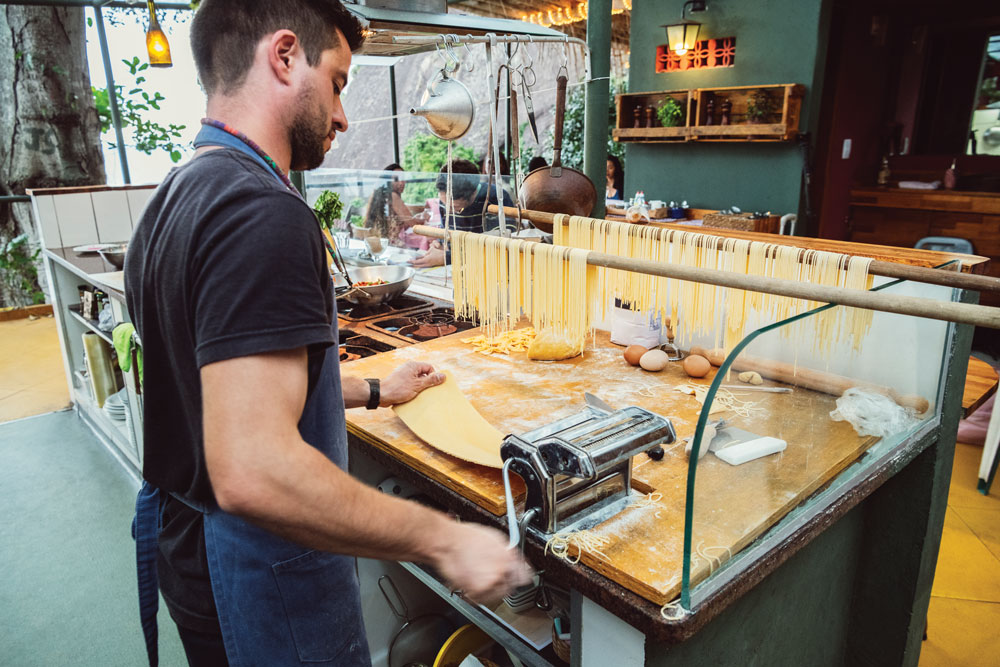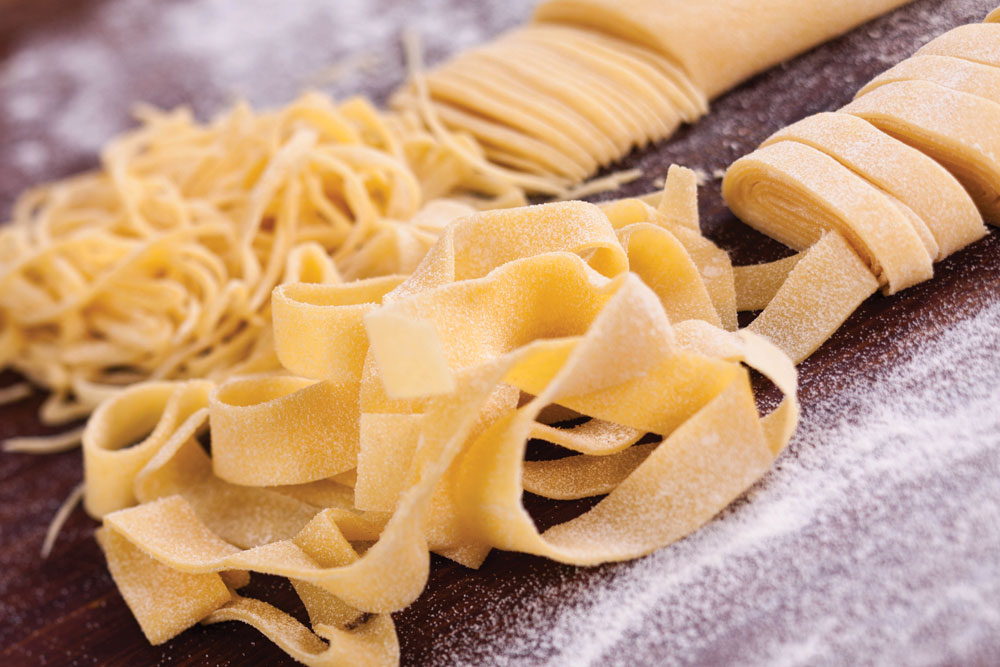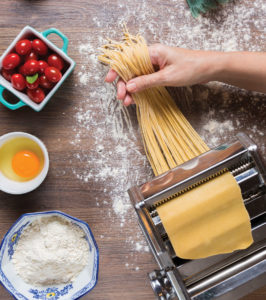If there’s one type of food that’s synonymous with Italian cuisine, it’s pasta. From spaghetti to fettuccine to cheese-stuffed ravioli, pasta is as old-world as you can get. The types and shapes number in the hundreds, and it can be served with a dizzyingly vast array of sauces and regional variations.
For some pointers to get you on the path to serving delicious, cost-effective pasta dishes that will raise your bottom line, we turned to Massimo Mannino of Nino’s Cucina Italiana in Greenville, North Carolina. With his practiced hand and years of experience, Mannino has won numerous awards, including the Pasta Challenge at the 2018 Northeast Pizza & Pasta Expo in Atlantic City, New Jersey. He makes his own dry and fresh pastas in-house for dishes such as Pappardelle Primavera and Spaghetti Pescatore. We asked Mannino to share some of his recipes, impart his knowledge of pasta—including the question of fresh vs. dry pasta—and offer tips on incorporating it into a pizzeria menu.
“The time and labor involved with making fresh pasta every day can be too much for an operation that is not solely focused on pasta. I would recommend offering one fresh pasta and getting a high-quality dried pasta from your distributor.”
— Massimo Mannino, Nino’s Cucina Italiana
PMQ: How did you get started in the restaurant industry and with pasta in particular?
Massimo Mannino: I started in the industry at Marabella’s in Sunnyside, Queens, New York, working for my father-in-law. It opened in 1984. I began making fresh pasta about 10 years ago. We started making it little by little in the restaurant, and people started liking it. Eventually, it got so popular I couldn’t keep up making it by hand, so I had to get a little machine. When we opened Nino’s, we made sure to have pasta on the menu right away.
PMQ: Would you recommend adding pasta to a pizzeria menu?
Mannino: I would definitely recommend that. When people buy pizza, they usually will buy pasta. I listened to the customers and what they were looking for. I remember working in New York. A customer called and said, “You got fettuccine Alfredo?” Then others would call asking for the same. Now we have it [on the menu]. From there, it was the same for other styles. It partially depended on customer demand and on what we wanted to add.

Fresh, handmade pasta is always on the menu at Nino’s Cucina Italiana in Greenville, North Carolina.
PMQ: If someone does add pasta to their menu, should they make it in-house or purchase it from a distributor?
Mannino: Obviously, fresh pasta’s flavor is amazing. But do I recommend a beginner doing an entirely fresh-pasta menu? Not really. Maybe one or two fresh items. The time and labor involved with making fresh pasta every day can be too much for an operation that is not solely focused on pasta. I would recommend offering one fresh pasta and getting a high-quality dried pasta from your distributor. But it definitely pays to do at least one freshly made pasta for your menu. You can even change the style of pasta day to day or week to week. It helps to create a buzz around your operation.
PMQ: Obviously, I couldn’t take a pizza dough ball from my shop and use it to make fresh linguine, right?
Mannino: No. I use an 80-20 blend of fancy durum and semolina flours for my spaghetti or dried pastas. I use a 50-50 blend of semolina and “00” flour and eggs for my fresh pasta. Pasta is definitely a different recipe than bread or pizza dough. Pasta can’t be made with just your everyday pizza dough. It takes a lot of mixing, rolling and care to make a good pasta dough. I recommend getting a pasta machine if you want to do multiple pastas. You don’t want the dough to dry out too much, and the machine will help you flatten and cut the pastas quicker. But I still start [the process] by hand; it just imparts that old-world touch.
PMQ: What is the shelf life of a housemade pasta, and how do you store it?
Mannino: I would say the shelf life is at least two weeks refrigerated in a sealed plastic bag. [Making a large batch] helps with costs, but after that first day, you are obviously moving further away from fresh and closer to dried.
Courtesy of Massimo Mannino
Ingredients:
- 2 c. fancy durum or “00” flour
- ½ c. semolina flour
- 1¼ tbsp. extra-virgin olive oil
- 1¼ tsp. salt
- 2-3 c. water (add as needed)
Directions:
Make a well in the center of the flour, and add 1 c. of water, olive oil and salt to the middle. Begin to mix by gradually adding the flour to the water in the middle and whisking with a fork. Keep adding flour, and eventually a dough will form.
Knead the pasta dough until it’s elastic. Add a little water if it’s too dry or sprinkle more flour if it’s too sticky. Knead for 10 to 12 minutes. You’re looking for a smooth and elastic consistency, which will develop the longer you knead the dough. Cover dough tightly with plastic wrap, and let it rest for around 30 minutes.
After the dough has rested, use a rolling pin to roll out the dough until it is very thin and in a rectangular shape. You can cut the dough in half and work in batches. Once you’re done and the dough is very thin, run through your pasta cutter for spaghetti. Sprinkle with some flour to prevent sticking together. Let the noodles dry on a rack for 20 minutes for best performance. Store unwrapped in a sealed plastic container pierced with a few holes; elevate humidity with a damp paper towel on the bottom of the container.
PMQ: What are the best toppings, garnishes or finishers for pasta?
Mannino: I like Parmigiano to finish it off. No matter what the dish, that always brings the flavor. I also love basil, but that depends on the sauce. I am moving more and more into using microgreens as well.
PMQ: Is there a good profit margin in pasta?
Mannino: There is. It’s harder to make that margin if you make all your own pasta because of labor costs and time spent making it, cleaning your equipment, and packaging or storing the pasta, but it can be done. You can purchase good-quality dried pastas and turn a good profit. But when I make my fresh pasta and the customer comes back for more—that’s why I do it, and that turns into profit, too. You must do it well, but nothing beats the flavor of fresh.
PMQ: Just for the beginner, what are the three best pasta dishes to start with?
Mannino: Alfredo pasta is the highest in demand. I would also put a lasagna on there—you can make a large tray of it and portion into individual servings as ordered. The last one would be an eggplant Parmesan. In my experience, these are the top three dishes that customers ask for.
Courtesy of Massimo Mannino
Ingredients:
- 1 lb. dry or fresh spaghetti
- 2 tbsp. extra-virgin olive oil
- 4 oz. pancetta or guanciale, cubed or cut into strips
- 4 garlic cloves, finely chopped
- 2 large egg yolks
- 1 egg, sunny-side up (optional, for garnish)
- 1 c. freshly grated Parmigiano-Reggiano, plus more for garnish
- Freshly ground black pepper
- Sea salt
- 1 handful fresh flat-leaf parsley, chopped
Directions:
Bring a large pot of salted water to a boil. Add the pasta and cook for 8 to 10 minutes, or until al dente. (Start cooking the spaghetti before you make the sauce so the pasta will be hot when you add the egg/cheese mixture. The hot pasta will cook the raw eggs in the sauce.)
Heat the olive oil in a deep skillet. Add the pancetta and sauté until it’s crisp and the fat is rendered. Add the garlic into the fat and sauté until light-golden in color. Meanwhile, beat two eggs and Parmigiano-Reggiano together in a bowl and set aside.
Drain the pasta and reserve ½ c. of the pasta water. Add the pasta to the deep skillet and toss to coat the pasta with the pancetta fat. Remove the skillet from the heat and pour the egg/cheese mixture into the pasta. Mix quickly until the eggs thicken. Use the reserved pasta water to thin out the sauce until you get the consistency you like. Season the carbonara with freshly ground black pepper and salt. Serve with chopped parsley and shaved Parmigiano-Reggiano. You can also garnish with the fried sunny-side up egg.
PMQ: What types of pasta making tools do you recommend for those who are just starting out?
Mannino: Two hands, a table and a rolling pin! Start it by hand. Eventually, if the sales pick up, definitely get a pasta machine, which is basically a dough press. You can also get attachments for that machine to cut your different pasta types—some crimpers for bowtie or stamps to make ravioli. For ravioli, make a big sheet of thinned pasta dough. Put your stuffing on, then add another thin sheet on top. Then you get a ravioli stamp and cut the stuffed raviolis out.

If demand for fresh pasta is high enough in your restaurant, you might want to look into buying a pasta machine with attachments.
PMQ: Sauce is typically the star of the dish. What do you recommend for a beginner?
Mannino: Again, Alfredo is No. 1. Second is a good red sauce—from scratch is always best, in my heart, but whatever works in your budget. After that, you can start trying out vodka sauces and others.
PMQ: When marketing a pasta dish that’s new on your menu, do you recommend offering deals?
Mannino: I think pasta will sell itself. If it has its own section on your menu above the pizzas and below the salads, people will see it and order it. You could offer a pasta dish with a large pizza at the beginning, but I don’t recommend that. Just see how it works putting it on the menu first.
PMQ: Speaking of marketing, tell me about your Parmesan Bowl. That sounds like something that markets itself!
Mannino: We do that at Nino’s. Basically, it’s a 50-pound wheel of Parmesan, cut in half and hollowed out in the center [into two bowls made of cheese]. We toss the fettuccine in the bowl with some grated Parmesan and olive oil, and it creates its own Alfredo sauce. This is the original Italian Alfredo sauce. We serve [individual portions of] the pasta from the cheese bowl—the customer never actually touches the bowl. You can clean the bowl with water and scrape it to make it fresh a few times before it’s used up. You’ll probably get about a week’s use out of it, but it can be used several times a night and pays for itself. It can be priced as a table dish or appetizer for everyone to try. It sells itself when people see it being wheeled to a table, tossed and served!
To learn more about pasta styles and infusions of flavors such as pumpkin and spinach, watch Brian’s full interview with Massimo Mannino at PMQ.com/mannino or catch the podcast at PizzaRadio on iTunes.
Brian Hernandez is PMQ’s test chef and coordinator of the U.S. Pizza Team.

















